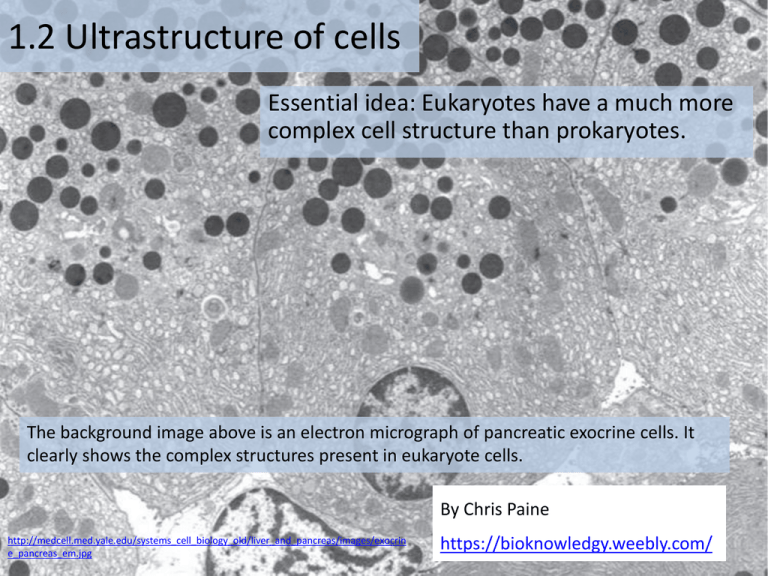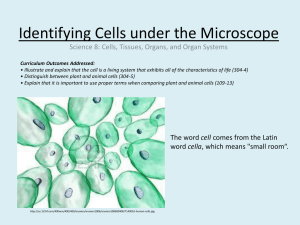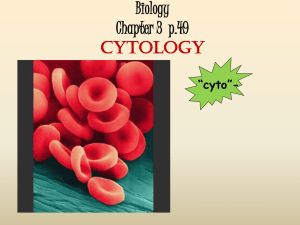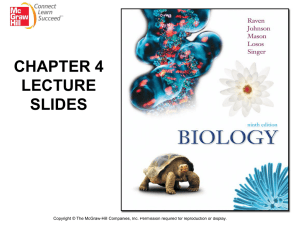1.2 Ultrastructure of Cells 2016
advertisement

1.2 Ultrastructure of cells Essential idea: Eukaryotes have a much more complex cell structure than prokaryotes. The background image above is an electron micrograph of pancreatic exocrine cells. It clearly shows the complex structures present in eukaryote cells. By Chris Paine http://medcell.med.yale.edu/systems_cell_biology_old/liver_and_pancreas/images/exocrin e_pancreas_em.jpg https://bioknowledgy.weebly.com/ Understandings, Applications and Skills 1.2.U1 1.2.U2 1.2.U3 1.2.A1 1.2.A2 1.2.S1 Statement Guidance Prokaryotes have a simple cell structure without compartmentalization. Eukaryotes have a compartmentalized cell structure. Electron microscopes have a much higher resolution than light microscopes. Structure and function of organelles within exocrine gland cells of the pancreas and within palisade mesophyll cells of the leaf. Prokaryotes divide by binary fission. Drawing of the ultrastructure of prokaryotic cells Drawings of prokaryotic cells should show the based on electron micrographs. cell wall, pili and flagella, and plasma membrane enclosing cytoplasm that contains 70S ribosomes and a nucleoid with naked DNA. 1.2.S2 Drawing of the ultrastructure of eukaryotic cells based on electron micrographs. 1.2.S3 Interpretation of electron micrographs to identify organelles and deduce the function of specialized cells. Drawings of eukaryotic cells should show a plasma membrane enclosing cytoplasm that contains 80S ribosomes and a nucleus, mitochondria and other membrane-bound organelles are present in the cytoplasm. Some eukaryotic cells have a cell wall. 1.2.U3 Electron microscopes have a much higher resolution than light microscopes. Resolution is defined as the shortest distance between two points that can be distinguished • • • Light microscopes are limited in resolution by the wavelengths of visible light (400–700 nm). Electrons have a much shorter wavelength (2 – 12 pm) therefore electron microscopes have a much higher resolution Light microscopes are usually limited to 1000x because, due to the resolution, nothing is gained by increasing the magnification – try zooming in on an image on your laptop or phone after a certain point there is no benefit to zooming in as the image becomes pixelated resolution Millimetres (mm) Micrometres (μm) Nanometres (nm) Human eye 0.1 100 100,000 Light microscopes 0.0002 0.2 200 Electron microscopes 0.000001 0.001 1 http://upload.wikimedia.org/wikipedia/commons/c/c5/Electron_Microscope.jpg 1.2.U3 Electron microscopes have a much higher resolution than light microscopes. Ultrastructure is all the structures of a biological specimen that are at least 0.1nm in their smallest dimension • • • Light microscopes allow us to see the structure of cells Electron microscopes allow us to see the ultrastructure of cells, such as these pancreatic exocrine cells Electron microscopes can see viruses (0.1μm diameter) , but light microscopes cannot http://medcell.med.yale.edu/systems_cell_biology_old/liver_and_pancreas/images/exocrine_pancreas_em.jpg 1.2.U1 Prokaryotes have a simple cell structure without compartmentalization. 1.2.U1 Prokaryotes have a simple cell structure without compartmentalization. Good web-links for learning about prokaryote ultrastructure: http://www.sheppardsoftware.com/health/anatomy/cell/bacteria_cell_tutorial.htm http://www.wiley.com/college/boyer/0470003790/animations/cell_structure/cell_structure.htm 1.2.U1 Prokaryotes have a simple cell structure without compartmentalization. Ultrastructure of E. coli as an example of a prokaryote http://www.tokresource.org/tok_classes/biobiobio/biomenu/metathink/required_drawings/index.htm • E. Coli is a model organism used in research and teaching. Some strains are toxic to humans and can cause food poisoning. • We refer to the cell parts/ultrastructure of prokaryotes rather than use the term organelle as very few structures in prokaryotes are regarded as organelles. 1.2.A2 Prokaryotes divide by binary fission. Prokaryotes reproduce asexually using the process of binary fission • The DNA is replicated semi conservatively [2.7.U1] • The two DNA loops attach to the membrane • The membrane elongates and pinches off (cytokinesis) forming two separate cells • The two daughter cells are genetically identically (clones) • Binary fission is also used by some organelles in eukaryotes [links to 1.5.U3] http://youtu.be/vTzH1P3aQjg https://commons.wikimedia.org/wiki/File:Binary_Fission.png http://cronodon.com/images/Bacteria_dividing_3b.jpg 1.2.S1 Drawing of the ultrastructure of prokaryotic cells based on electron micrographs. 1.2.S1 Drawing of the ultrastructure of prokaryotic cells based on electron micrographs. 1.2.S1 Drawing of the ultrastructure of prokaryotic cells based on electron micrographs. 1.2.U2 Eukaryotes have a compartmentalized cell structure. There are several advantages in being compartmentalized: • Effeciency of metabolism - enzymes and substrates can localized and much more concentrated • Localised conditions - pH and other such factors can be kept at optimal levels. The optimal pH level for one process in one part of the cell • Toxic / damaging substances can be isolated, e.g. digestive enzymes (that could digest the cell itself) are stored in lysosomes • Numbers and locations of organelles can be changed dependent on the cell’s requirements. http://medcell.med.yale.edu/systems_cell_biology_old/liver_and_pancreas/images/exocrine_pancreas_em.jpg 1.2.U2 Eukaryotes have a compartmentalized cell structure. 1.2.U2 Eukaryotes have a compartmentalized cell structure. Vesicle membrane sac containing proteins ready for secretion http://www.tokresource.org/tok_classes/biobiobio/biomenu/eukaryotic_cells/liver_cell_500.jpg 1.2.A1 Structure and function of organelles within exocrine gland cells of the pancreas and within palisade mesophyll cells of the leaf. Nucleus • Generally spherical with a double membrane • Pores (holes) are present in the membrane • Contains genetic information in the form of chromosomes (DNA and associated histone proteins) • Uncoiled chromosomes are referred to as chromatin – they stain a dark colour and are concentrated at the edges of the nucleus • mRNA is transcribed in the nucleus (prior to use in protein synthesis in the cytoplasm) • mRNA leaves the nucleus via the pores (DNA is too large to move through the pores) http://courses.lumenlearning.net/biology/wp-content/uploads/sites/5/2014/02/Figure_03_03_05.jpg http://upload.wikimedia.org/wikipedia/commons/5/57/Micrograph_of_a_cell_nucleus.png 1.2.A1 Structure and function of organelles within exocrine gland cells of the pancreas and within palisade mesophyll cells of the leaf. The Mitochondrion (pl. Mitochondria) • Has a double membrane • A smooth outer membrane and a folded inner membrane • The folds are referred to as cristae • Variable in shape • Site of ATP production by aerobic respiration (if fat is used as a source of energy it is digested here) Mitochondria in mammalian lung cells http://ibguides.com/images/biology_figure_8.1.2_mitochondrion.png http://commons.wikimedia.org/wiki/File:Mitochondria,_mammalian_lung_-_TEM.jpg 1.2.A1 Structure and function of organelles within exocrine gland cells of the pancreas and within palisade mesophyll cells of the leaf. Free ribosomes • 80S Ribosomes (approx. 20nm diameter) - larger than the ribosomes found in prokaryotes • No membrane • These appear as dark granules in the cytoplasm • Synthesizes proteins to function in the cytoplasm, for use within the cell, e.g. enzymes http://www.cc.kochi-u.ac.jp/~tatataa/genetics/Q2013/ribosome2.jpg 1.2.A1 Structure and function of organelles within exocrine gland cells of the pancreas and within palisade mesophyll cells of the leaf. The Rough Endoplasmic Reticulum (rER) • The consists of flattened membrane sacs, called cisternae • Often located near to the nucleus • 80S Ribosomes are attached to the outside of the cisternae are ribosomes • rER synthesizes proteins which are transported, by vesicles, to the golgi apparatus for modification before secretion outside the cell Smooth Endoplasmic Reticulum • no ribosomes present • we are not studying this structure it this course Need a simple diagram 1.2.A1 Structure and function of organelles within exocrine gland cells of the pancreas and within palisade mesophyll cells of the leaf. The Golgi apparatus • This organelle also consists of flattened membrane sacs called cisternae, like rER. • Different to rER: o No attached ribosomes o Often sited close to the plasma membrane o The cisternae are shorter and more curved that those of the rER • The Golgi apparatus processes (modifies) proteins from from the rER. The proteins are then repackaged in vesicles for secretion outside the cell. Need a simple diagram http://commons.wikimedia.org/wiki/File:C_Golgi.jpg http://commons.wikimedia.org/wiki/File:Golgi_in_the_cytoplasm_of_a_macrophage_in_the_alveolus_(lung)_-_TEM.jpg 1.2.A1 Structure and function of organelles within exocrine gland cells of the pancreas and within palisade mesophyll cells of the leaf. Vesicles • A single membrane with fluid inside • Very small in size • Used to transport materials inside of a cell Need a simple diagram http://commons.wikimedia.org/wiki/File:C_Golgi.jpg http://commons.wikimedia.org/wiki/File:Golgi_in_the_cytoplasm_of_a_macrophage_in_the_alveolus_(lung)_-_TEM.jpg 1.2.A1 Structure and function of organelles within exocrine gland cells of the pancreas and within palisade mesophyll cells of the leaf. Lysosomes • Generally spherical with a single membrane • Formed from Golgi vesicles. • They contain digestive enzymes for breakdown of: o ingested food in vesicles o unwanted/damaged organelles o The cell itself • High concentration of enzymes (a type of protein) cause this organelle to stain heavily and hence appear dark on micrographs http://1.bp.blogspot.com/-WGspbEtlkls/TgCUbtp7_-I/AAAAAAAAAJw/SoIp2vXzH4E/s320/Figure+2-26.bmp 1.2.A1 Structure and function of organelles within exocrine gland cells of the pancreas and within palisade mesophyll cells of the leaf. Vacuoles • Single membrane with fluid inside • In Plant cells vacuoles are large and permanent, often occupying the majority of the cell volume • In animals vacuoles are smaller and temporary and used for various reasons, e.g. to absorb food and digest it http://middletownhighschool.wikispaces.com/file/view/ch13f20.jpg/173915407/ch13f20.jpg 1.2.A1 Structure and function of organelles within exocrine gland cells of the pancreas and within palisade mesophyll cells of the leaf. Flagellum (Flagella pl.) • Thin projection (usually singular) from the cell surface. • Contain microtubules • Used to move the cell *Mature plant cells do not possess possess cilia and flagella, but some plant gametes are motile and do have them. This is not a common occurrence and you would not be expected to know about this. http://medicine.utah.edu/surgery/andrology/images/P29SERIES2-4.JPG 1.2.A1 Structure and function of organelles within exocrine gland cells of the pancreas and within palisade mesophyll cells of the leaf. Cilia • Thin projections from the cell surface. • Contain microtubules • Used to either move the cell or to move the fluids next to the cell *Mature plant cells do not possess possess cilia and flagella, but some plant gametes are motile and do have them. This is not a common occurrence and you would not be expected to know about this. http://cache1.asset-cache.net/gc/139809475-shows-cilia-pseudostratifed-structure-gobletgettyimages.jpg?v=1&c=IWSAsset&k=2&d=ut2a821i%2BSbReC5nXMMSneS7x9HksglF3dCo8uKSNT1EglzTjjv58OvCiQSlcyy0 1.2.A1 Structure and function of organelles within exocrine gland cells of the pancreas and within palisade mesophyll cells of the leaf. Microtubules • Small cylindrical fibres called microtubules • Have a variety of functions, e.g. part of the structure of flagella and they play a role in cell division Centrioles • Consist of two groups of nine triple microtubules • Are mainly found in animal cells, not present in vascular plants or fungi. https://encrypted-tbn1.gstatic.com/images?q=tbn:ANd9GcSrrSOHTtgbp2fiBrTjBtL1sBOhi0i5z0pf4oWpQ9EdTqr_-IN9OQ 1.2.A1 Structure and function of organelles within exocrine gland cells of the pancreas and within palisade mesophyll cells of the leaf. Chloroplast • • • • • • • Many, but not all, plant cells contain chloroplasts A double membrane surrounds the chloroplast Inside are stacks of thylakoids Each thylakoid is a disc composed of a flattened membrane The shape of chloroplasts is variable but is usually ovoid The site of photosynthesis and hence where glucose is produced. Starch grains maybe present if photosynthesis is happening quickly https://benchprep.com/blog/wp-content/uploads/2012/08/chloroplast2.jpg http://www.biology.arizona.edu/biochemistry/problem_sets/photosynthesis_1/graphics/chloroplast.GIF 1.2.A1 Structure and function of organelles within exocrine gland cells of the pancreas and within palisade mesophyll cells of the leaf. Cell wall • an extracellular component not an organelle. • secreted by all plant cells (fungi and some protists also secrete cell walls). • Plant cell walls consist mainly of cellulose which is: o Permeable - does not affect transport in and out of the cell o Strong – gives support to the cell and prevent the plasma membrane bursting when under pressure o Hard to digest –resistant to being broken down, therefore lasts along time without the need for replacement/maintenance http://www.oncoursesystems.com/images/user/9341/10845583/01-03_PlantCell(L-Large).jpg 1.2.S2 Drawing of the ultrastructure of eukaryotic cells based on electron micrographs. Draw a pancreas exocrine cellfrom the image below. You should be able to label the following structures: • plasma membrane • mitochondria • rER • Nucleus • Secretory granules (dark spheres) http://medcell.med.yale.edu/systems_cell_biology_old/liver_and_pancreas/images/exocrine_pancreas_em.jpg 1.2.S2 Drawing of the ultrastructure of eukaryotic cells based on electron micrographs. Draw a single palisade mesophyll cell from the image below. You should be able to label the following structures: • cell wall • plasma membrane • chloroplasts • vacuole • nucleus • cytoplasm • mitochondria http://www.lifesci.sussex.ac.uk/home/Julian_Thorpe/TEM19.htm 1.2.S3 Interpretation of electron micrographs to identify organelles and deduce the function of specialized cells. 1.2.S3 Interpretation of electron micrographs to identify organelles and deduce the function of specialized cells. 1.2.S3 Interpretation of electron micrographs to identify organelles and deduce the function of specialized cells. What organelles can you identify? Think about the role of the organelles that occur most common and deduce the function of the cell. 1.2.S3 Interpretation of electron micrographs to identify organelles and deduce the function of specialized cells. What organelles can you identify? Think about the role of the organelles that occur most common and deduce the function of the cell. Evidence & conclusions: • Nucleus present • No cell wall – this is an animal cell • rER is present and dominates the cell – lots of protein product is made for secretion • Lots of mitochondria – the synthesis of protein requires enegy – this a metabolically active cell • Lots of secretory granules/vesicles near the inside border • Likely to be a cell that specializes in secreting a protein product, possibly a hormone or enzyme • Is in fact: a mammalian exocrine secretory cell from the pancreas 1.2.S3 Interpretation of electron micrographs to identify organelles and deduce the function of specialized cells. What organelles can you identify in the top most layer of cells? Think about the role of the organelles that occur most common and deduce the function of the cell. http://bcrc.bio.umass.edu/histology/files/images/Pseudostratified%20Columnar%20Ciliated%20Epithelium1.jpg 1.2.S3 Interpretation of electron micrographs to identify organelles and deduce the function of specialized cells. What organelles can you identify in the top most layer of cells? Think about the role of the organelles that occur most common and deduce the function of the cell. Evidence & conclusions: • Nucleus present • No cell wall – this is an animal cell • Cells closely packed – does not allow infiltration of substances from the lumen • Has a cilia dominated ‘brush border’ adjacent to a lumen – cilia are moving fluids in the lumen • Likely to be a protective layer of cells that actively sweep fluids away from the surface • Is in fact: ciliated epithelial cell from a mammalian lung http://bcrc.bio.umass.edu/histology/files/images/Pseudostratified%20Columnar%20Ciliated%20Epithelium1.jpg 1.2.S3 Interpretation of electron micrographs to identify organelles and deduce the function of specialized cells. What organelles can you identify? Think about the role of the organelles that occur most common and deduce the function of the cell. http://www.vcbio.science.ru.nl/images/tem-plant-cell.jpg 1.2.S3 Interpretation of electron micrographs to identify organelles and deduce the function of specialized cells. What organelles can you identify? Think about the role of the organelles that occur most common and deduce the function of the cell. Evidence & conclusions: • Cell wall present – must be a plant cell • No chloroplasts – must be found inside the stem or in the roots • Vacuoles relatively small – the cell does not have a storage, transport or support function • Nucleus relatively large / cell size small – likely to be a new cell recently undergone mitosis • Possibly recently divided cell tissue from a plant root Is in fact: a plant cell found at the root-tip http://www.vcbio.science.ru.nl/images/tem-plant-cell.jpg Bibliography / Acknowledgments Jason de Nys








